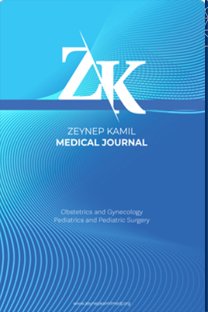Evaluation of etiological, laboratory, and anthropometric characteristics of patients treated with the diagnosis of precocious puberty
Evaluation of etiological, laboratory, and anthropometric characteristics of patients treated with the diagnosis of precocious puberty
___
- 1. Teilmann G, Pedersen CB, Jensen TK, Skakkebæk NE, Juul A. Prevalence and incidence of precocious pubertal development in Denmark: An epidemiologic study based on national registries. Pediatrics 2005;116(6):1323–8.
- 2. Euling SY, Selevan SG, Pescovitz OH, Skakkebaek NE. Role of environmental factors in the timing of puberty. Pediatrics 2008;121(3):167–71.
- 3. Kaplowitz P, Bloch C. Evaluation and referral of children with signs of early puberty. Pediatrics 2016;137(1):e20153732.
- 4. Jung MK, Song KC, Kwon AR, Chae HW, Kim DH, Kim HS. Adult height in girls with central precocious puberty treated with gonadotropin-releasing hormone agonist with or without growth hormone. Ann Pediatr Endocrinol Metab 2014;19(4):214–9.
- 5. Bundak R, Furman A, Gunoz H, Darendeliler F, Bas F, Neyzi O. Body mass index references for Turkish children. Acta Paediatr 2006;95(2):194–8.
- 6. Kandemir N, Demirbilek H, Özön ZA, Gönç N, Alikaşifoğlu A. GnRH stimulation test in precocious puberty: Single sample is adequate for diagnosis and dose adjustment. J Clin Res Pediatr Endocrinol 2011;3(1):12–7.
- 7. Mogensen SS, Aksglaede L, Mouritsen A, Sørensen K, Main KM, Gideon P, et al. Diagnostic work-up of 449 consecutive girls who were referred to be evaluated for precocious puberty. J Clin Endocrinol Metab 2011;96(5):1393–401.
- 8. Tirumuru SS, Arya P, Latthe P. Understanding precocious puberty in girls. Obstet Gynaecol 2012;14(2):121–9.
- 9. Rohani F, Salehpur S, Saffari F. Etiology of precocious puberty, 10 years study in Endocrine Reserch Centre (Firouzgar), Tehran. Iran J Reprod Med 2012;10(1):1–6.
- 10. Shiva S, Fayyazi A, Melikian A, Shiva S. Causes and types of precocious puberty in North-West Iran. Iran J Pediatr 2012;22(4):487.
- 11. Kılınç S. Assessment of normal, normal variants, and precocious puberty in children referred with signs of early pubertal development to a pediatric endocrine unit. Haydarpasa Numune Med J 2019;59(1):71–7.
- 12. Lee J, Kim J, Yang A, Cho SY, Jin DK. Etiological trends in male central precocious puberty. Ann Pediatr Endocrinol Metab 2018;23(2):75–80.
- 13. Carel JC, Lahlou N, Roger M, Chaussain JL. Precocious puberty and statural growth. Hum Reprod Update 2004;10(2):135–47.
- 14. Rapaport R, Logrono R. Primary empty sella syndrome in childhood: Association with precocious puberty. Clin Pediatr (Phila) 1991;30(8):466–71.
- 15. Deng X, Li W, Luo Y, Liu S, Wen Y, Liu Q. Association between small fetuses and puberty timing: A systematic review and meta-analysis. Int J Environ Res Public Health 2017;14(11):1377.
- 16. Voordouw JJ, van Weissenbruch MM, Delemarre-van de Waal HA. Intrauterine growth retardation and puberty in girls. Twin Res 2001;4(5):299– 306.
- 17. Mogensen SS, Aksglaede L, Mouritsen A, Sørensen K, Main KM, Gideon P, et al. Pathological and incidental findings on brain MRI in a single-center study of 229 consecutive girls with early or precocious puberty. PLoS One 2012;7(1):e29829.
- 18. Li W, Liu Q, Deng X, Chen Y, Liu S, Story M. Association between obesity and puberty timing: A systematic review and meta-analysis. Int J Environ Res Public Health 2017;14(10):1266.
- 19. Solorzano CM, McCartney CR. Obesity and the pubertal transition in girls and boys. Reproduction 2010;140(3):399–410.
- 20. Berberoğlu M. Precocious puberty and normal variant puberty: Definition, etiology, diagnosis and current management. J Clin Res Pediatr Endocrinol 2009;1(4):164–74.
- 21. Vurallı D, Gönç EN, Özön ZA, Alikaşifoğlu A. Adequacy of basal luteinizing hormone levels in the diagnosis of central precocious puberty. Turk Pediatri Ars 2020;55(2):131–8.
- 22. Resende EA, Lara BH, Reis JD, Ferreira BP, Pereira GA, Borges MF. Assessment of basal and gonadotropin-releasing hormone-stimulated gonadotropins by immunochemiluminometric and immunofluorometric assays in normal children. J Clin Endocrinol Metab 2007;92(4):1424–9.
- 23. Savaş-Erdeve Ş, Şıklar Z, Hacıhamdioğlu B, Kocaay P, Çamtosun E, Öcal G, et al. Gonadotropin-releasing hormone analogue treatment in females with moderately early puberty: No effect on final height. J Clin Res Pediatr Endocrinol 2016;8(2):211–7.
- 24. Arcari AJ, Gryngarten MG, Freire AV, Ballerini MG, Ropelato MG, Bergadá I, et al. Body mass index in girls with idiopathic central precocious puberty during and after treatment with GnRH analogues. Int J Pediatr Endocrinol 2016;2016:15.
- 25. Anık A, Çatlı G, Abacı A, Böber E. Effect of gonadotropin-releasing hormone agonist therapy on body mass index and growth in girls with idiopathic central precocious puberty. Indian J Endocrinol Metab 2015;19(2):267–71.
- ISSN: 1300-7971
- Yayın Aralığı: Yılda 4 Sayı
- Yayıncı: Ali Cangül
Hasan Hüseyin MUTLU, Elif YÜKSEL KARATOPRAK, Müferet ERGÜVEN, Nilüfer ÇETİNER
PET/CT dilemma in para-aortic lymph node assessment in locally advanced cervical cancer?
Tayup ŞİMŞEK, Selen DOĞAN, Özer BİRGE, Mehmet Sait BAKIR, Hasan Aykut TUNCER, Ceyda KARADAĞ
Acute dystonia after domperidone use: A rare and an unexpected side effect
Salih DEMİRHAN, Özlem ERDEDE, Rabia Gönül SEZER YAMANEL
Evaluation of the relationship between method of delivery and breastfeeding characteristics
Selcuk UZUNER, Feyza USTABAŞ KAHRAMAN, Beyza MAŞLAK
Oncologic breast surgery of retroareolar breast cancer with racquet mammoplasty technique
Bilateral serous macular detachment as a complication of preeclampsia: A case report
Özkan KOCAMIŞ, Emine TEMEL, Kemal ÖRNEK, Nazife Aşıkgarip
